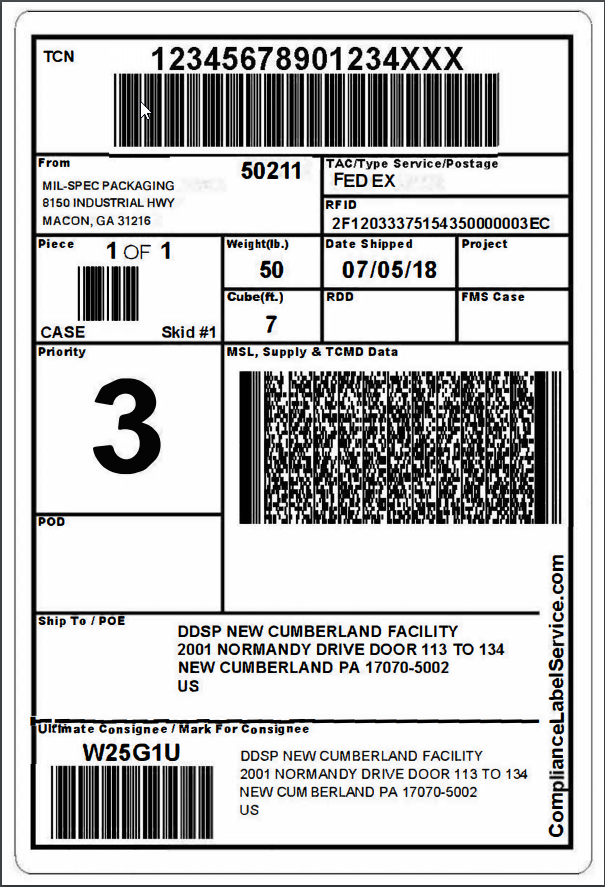The U.S. government maintains specific regulations regarding how package markings must look when contractors are shipping to civilian and military agencies.
These strict military standards require suppliers to correctly label and mark shipments of supplies on all levels of packaging, from the unit pack to the pallet. Markings are comprised of certain numbers, letters, labels, tags, symbols, and colors, all of which provide clear identification and serve to expedite handling during shipment and storage processes.
Military Packaging Standards
Various standards guide these markings. Military Standard 129 (MIL-STD-129) requirements are used to maintain uniformity while marking military equipment and supplies that are transported through ships.
Military Standard 130 (MIL-STD-130) governs “identification marking of U.S. military property,” and is commonly used for providing directions on how to mark items sold to the Department of Defense (DOD). In 2005, the rule was modified to include unique identifier (UID) data matrix machine-readable information (MRI) requirements.
The team at Mil-Spec Packaging is proud to provide Mil-Spec labels that meet all these stringent industry requirements.
Features and Applications of Different Military Shipping Labels
- Per MIL-STD-129 requirements, shipping containers carrying military items are categorized into three types: unit, intermediate, and exterior. For all types of containers, basic information — such as National Stock Number (NSN), item description, and part number — is mandatory. For exterior containers, additional identifiers — such as Commercial and Government Entity Code (CAGE) Code, contract number, Military Shipment Label (MSL), serial number barcode, and Direct-Vendor Delivery label (DVD) — are required.
- A 2007 revision to MIL-STD-129 packaging also added two new required bar codes — Contract Line Item (CLIN) and Shipment Numbers (SN). Revision R, which went into effect in 2014, called for the use of two-dimensional PDF417 barcode symbols to replace linear barcodes on container identification labels.PDF417 symbols are designed to accommodate the unique demands of UID markings. This change has reduced the number of labels required, allowing depots to easily read the remaining ones with automated data collection systems.
- MIL-STD-130, on the other hand, describes the materials allowed, minimum text size and fonts, format, syntax and rules for identifying marks on a part, where to locate the marking, and exceptions and unique situations.
- The DOD makes use of a single UID for all department activity; all possessions are logged with the purchase date, purchase price, and dates when they were sent for repairs/refurbishments or decommissioning. Under the UID system, items are assigned a number, character string, or a sequence of bits that uniquely distinguish them from other entities.
- Making use of highly durable — or even permanent — Mil-Spec labels is imperative for the success of the UID process. Materials range from aluminum and stainless steel to polyester and polyimide adhesive-backed stickers.
Learn More
Mil-Spec Packaging is proud to be a leader in the military-spec packaging sector. Clients can rest assured that we will meet all their MSL packaging needs while easily meeting, or even exceeding, the requirements set forth by the U.S. military and relevant government agencies.
To learn more about how we can assist with your specific military standard shipping labeling needs, request a quote from the team today.
Features and Applications of Different Military Labels
- Per MIL-STD-129, shipping containers carrying military items are categorized into three types: unit, intermediate, and exterior. For all types of containers, basic information — such as National Stock Number (NSN), item description, and part number — is mandatory. For exterior containers, additional identifiers — such as Commercial and Government Entity Code (CAGE) Code, contract number, Military Shipment Label (MSL), serial number barcode, and Direct-Vendor Delivery label (DVD) — are required.
- A 2007 revision to MIL-STD-129 also added two new required bar codes — Contract Line Item (CLIN) and Shipment Numbers (SN). Revision R, which went into effect in 2014, called for the use of two-dimensional PDF417 barcode symbols to replace linear barcodes on container identification labels.PDF417 symbols are designed to accommodate the unique demands of UID markings. This change has reduced the number of labels required, allowing depots to easily read the remaining ones with automated data collection systems.
- MIL-STD-130, on the other hand, describes the materials allowed, minimum text size and fonts, format, syntax and rules for identifying marks on a part, where to locate the marking, and exceptions and unique situations.
- The DOD makes use of a single UID for all department activity; all possessions are logged with the purchase date, purchase price, and dates when they were sent for repairs/refurbishments or decommissioning. Under the UID system, items are assigned a number, character string, or a sequence of bits that uniquely distinguish them from other entities.
- Making use of highly durable — or even permanent — MIL-STD 129 labels is imperative for the success of the UID process. Materials range from aluminum and stainless steel to polyester and polyimide adhesive-backed stickers.
Learn More
Mil-Spec Packaging is proud to be a leader in the military-spec packaging sector. Clients can rest assured that we will meet all of their packaging needs while easily meeting, or even exceeding, the requirements set forth by the U.S. military and relevant government agencies. To learn more about how we can assist with your specific military labeling needs, request a quote from the team today.


